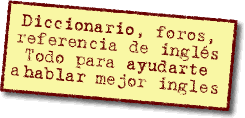Hacer PreguntaCrear un tema |
|
|||||||
Tu, Te, TiÉste es el lugar para preguntas sobre conjugaciones, tiempos verbales, adverbios, adjetivos, el orden de palabras, sintaxis y otras cuestiones gramaticales en español e inglés. |
 |
|
|
Herramientas | Desplegado |
|
#1
|
|||
|
|||
|
I've been trying to help my boyfriend learn Spanish and I've been trying to explain to him when to use tu, te and ti, but i think i'm just making it worse
 Spanish is my native language, but since i was raised in the US since I was 1 my grammar isn't up to par. So if you guys could help me i would appreciate it!!! Spanish is my native language, but since i was raised in the US since I was 1 my grammar isn't up to par. So if you guys could help me i would appreciate it!!! 
|
|
Quita esta publicidad al registrarte con una cuenta gratuita en TomĂsimo.
|
|
#2
|
||||
|
||||
|
Welcome Luna,
That's a good question, and I'll try to explain it as best I can. Hopefully someone else will give it a shot too. Tu Tu is the subject pronoun - the person doing the main action in the sentence. Tu is optional in Spanish (unlike English), you don't have to use it. You're driving too fast.Te Te is the direct object pronoun - the person or thing directly affected by the action (receiving the action) in the sentence. Te goes before the main verb in the sentence, as opposed to English where it usually goes after the main verb. I love you.Te is also the indirect object pronoun - the person or thing indirectly affected or benefited by the action of the sentence. (Yo) te doy el libro.Ti Ti is a prepositional pronoun, meaning that it goes with a preposition such as para or a. Esto es para tĂ.I hope this explanation helps 
__________________
If you find something wrong with my Spanish, please correct it! |
|
#3
|
|||
|
|||
|
Like Luna, I too am having a very difficult time with this stuff. I have already inquired about using "le", "lo", etc. Here are a couple of sentences I came across yesterday:
Le estoy escribiendo un mensaje electrónico a mi madre. Él le da flores a su mujer. What is the purpose of "le"? Why can't you just say: Estoy escribiendo un mensaje electrónico a mi madre. Él da flores a su mujer. HELP! Remember, I don't understand the "subjunctive" stuff. You need to keep it simple for stupid.  Thanks!
__________________
~ Brenda |
|
#4
|
||||
|
||||
|
Great question!
Cita:
I'm writing her an email - Le estoy escribiendo un correoIn the above examples, le serves as the indirect object pronoun, showing who you're giving flowers to and who you're writing to, just like her in the English version. When you want to give more specific info about the person receiving the flowers or email, in English you remove the her and replace it with the prepositional phrase "to my mother". I'm writingIn Spanish, when you add the prepositional phrase, you don't remove the indirect object pronoun. They are both needed. Le estoy escribiendo un correo a mi madre.It would be something like this literally translated to English: * I'm writing her an email to my mother.Both the her and to my mother are needed in Spanish; In English you must use one or the other.
__________________
If you find something wrong with my Spanish, please correct it! |
|
#5
|
|||
|
|||
|
GRACIAS! You guys have made my translating life easier
 I've also been poking around in the other forums trying to improve my spanish. Creo que hasta ahora he estado haciendo un buen trabajo, pero me estoy dando cuenta que todavia me falta un resto  Yo me enseñe a escribir y leer español sola, leyendo articulos y libros, pero nunca aprendi toda la grammatica que tiene que ver con el español. Entonces cuando mi novio decidio aprender se me vino el mundo encima Yo me enseñe a escribir y leer español sola, leyendo articulos y libros, pero nunca aprendi toda la grammatica que tiene que ver con el español. Entonces cuando mi novio decidio aprender se me vino el mundo encima  Asi que les agradezco el esfuerzo que hicieron para ayudarme Asi que les agradezco el esfuerzo que hicieron para ayudarme 
|
|
#6
|
||||
|
||||
|
Hola Luna.....
Dices que te enseñaste el Español sola, con solo leer articulos y libros, pues eres una excelente maestra y alumna! ¡Felicidades! Lo haces muy bien y creo que la gramatica, aunque un poco confusa, la vas a entender muy pronto. Elaina 
|
 |
| Etiquetas |
| indirect object, le |
«
Tema Anterior
|
PrĂłximo Tema
»
| Link to this thread | |
|
|
|||||||
La franja horaria es GMT -6. Ahora son las 06:17 AM.









 Modo Lineal
Modo Lineal

